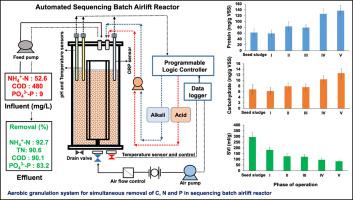Journal of Environmental Chemical Engineering ( IF 7.4 ) Pub Date : 2021-07-21 , DOI: 10.1016/j.jece.2021.106100 Swathi Desireddy 1 , P.C. Sabumon 1

|
Conventional biological nutrient removal techniques often have disadvantages like low removal efficiencies, requirement of large footprint, and excess sludge production. Ever increasing stringent discharge standards demand for alternative technologies. In this context aerobic granular sludge (AGS) has evolved as a promising technology for complete nutrient removal. However, degradation of structural integrity of aerobic granules in long run is a prime concern of this technology. This work attempts to develop stable aerobic granules in an automated sequential batch airlift reactor (SBAR) for simultaneous C, N, and P removals under alternating aerobic and anoxic conditions. The reactor was operated at high sludge retention time (SRT). Combined operating strategies of varying dissolved oxygen (DO) concentration and feed cycle times were followed to optimize the conditions for effective granulation and subsequent removal efficiencies. Profiles of extracellular polymeric substances (EPS) and sludge volume index (SVI) were monitored. Optimum removal efficiencies of NH4+-N (92.7%), TN (90.6%), COD (90.1%), and PO43--P (83.2%), and granules of size 1.3 to 8 mm were achieved in phase IV at operational DO of 1 to 2 mg/L, and feeding intervals of 15 h and 9 h. NH4+-N (R2 = 0.97, k = 0.5093/h) and PO43--P (R2 = 0.95, k = 0.2574/h) removals were fitted well with first order kinetic model and that of COD (R2 = 0.97, k = 0.0032 L/mg/h) followed second order kinetics. This process is economical as effective biological nutrient and organics removal occurs in a single reactor without requirement of alkalinity supply, and negligible excess sludge production. The process requires small foot print and applicable for decentralized wastewater management in University campuses/tourist resorts/apartment complexes.
中文翻译:

序批式气升反应器C、N、P同时脱除好氧造粒系统的研制
传统的生物养分去除技术通常具有去除效率低、需要大占地面积和产生过量污泥等缺点。对替代技术的日益严格的排放标准要求。在这种情况下,好氧颗粒污泥 (AGS) 已发展成为一种有前途的完全去除养分的技术。然而,从长远来看,好氧颗粒结构完整性的退化是该技术的主要关注点。这项工作试图在自动顺序间歇气升反应器 (SBAR) 中开发稳定的好氧颗粒,以便在交替的好氧和缺氧条件下同时去除 C、N 和 P。反应器在高污泥停留时间(SRT)下运行。遵循不同溶解氧 (DO) 浓度和进料循环时间的组合操作策略,以优化有效造粒和后续去除效率的条件。监测细胞外聚合物 (EPS) 和污泥体积指数 (SVI) 的分布。NH 的最佳去除效率4 + -N (92.7%)、TN (90.6%)、COD (90.1%) 和 PO 4 3- -P (83.2%) 以及 1.3 至 8 毫米大小的颗粒在阶段 IV 中在操作 DO 下实现1至2 毫克/升,喂食间隔为15 小时和9 小时。NH 4 + -N (R 2 = 0.97, k = 0.5093/h) 和 PO 4 3- -P (R 2 = 0.95, k = 0.2574/h) 的去除与一阶动力学模型和 COD ( R 2 = 0.97,k = 0.0032 L/mg/h) 遵循二级动力学。这个过程是经济的,因为有效的生物养分和有机物去除发生在单个反应器中,不需要碱度供应,剩余污泥产量可以忽略不计。该过程需要占用很小的空间,适用于大学校园/旅游胜地/公寓大楼的分散式废水管理。











































 京公网安备 11010802027423号
京公网安备 11010802027423号